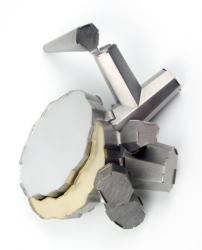
Susan Cummins: Before we start with the more in-depth questions, please tell me how you came to be where you are, doing what you are doing.
Simon Cottrell: In 1997, I completed a bachelors degree in fine arts with honors, majoring in gold and silversmithing at Royal Melbourne Institute of Technology (RMIT). During my early years at RMIT, Carlier Makigawa and Robert Baines were teachers of the greatest influence.
From 1997 to 2008, I also worked with Robert as his assistant on his own work. This was a remarkably valuable experience through which I learned more than I knew was even possible about working with metal. Making your own work is very different from working with another artist on their work. It forces you to work in ways that are both conceptually and technically outside of your personal logic. It is the best way to learn while working.

Susan Cummins: Before we start with the more in-depth questions, please tell me how you came to be where you are, doing what you are doing.
Simon Cottrell: In 1997, I completed a bachelors degree in fine arts with honors, majoring in gold and silversmithing at Royal Melbourne Institute of Technology (RMIT). During my early years at RMIT, Carlier Makigawa and Robert Baines were teachers of the greatest influence.
From 1997 to 2008, I also worked with Robert as his assistant on his own work. This was a remarkably valuable experience through which I learned more than I knew was even possible about working with metal. Making your own work is very different from working with another artist on their work. It forces you to work in ways that are both conceptually and technically outside of your personal logic. It is the best way to learn while working.
From 2002 to 2011, I taught metals and jewelry at the school of art and design at Monash University in Melbourne. Marian Hosking was the head of the metals and jewelry studio, and during that time she provided great support to my own practice. I also occasionally taught in the gold and silversmithing studio at RMIT.
Through teaching I came to understand that there is no point in being passionate about something if you cannot also actively facilitate and further that same passionate interest in others. Effective education in the creative arts really has to be a two way working relationship between teacher and student. I have no interest in directing students to be disciples of my own thinking and values. Instead, I try to develop a high degree of self questioning and self awareness to enable students to discover and refine their own creative priorities, aims, and intentions. This hopefully creates effective correlations between thinking process and material or tangible outcomes.
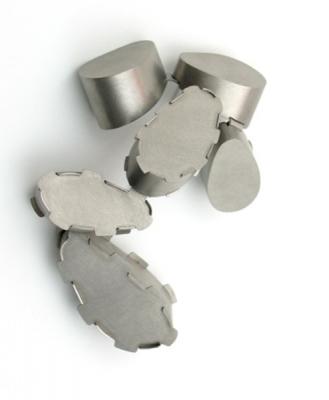
In 2011, I left Melbourne and moved my life and studio to Canberra to take an academic research and lecturing position in the gold and silversmithing workshop in the school of art at the Australian National University (ANU). I am currently the acting head of this workshop.
All this time I have been committed to making jewelry and objects. First, it was neckpieces, pendants, and containers, but then I became quite fixated on brooches for the past 11 years. During the past 15 years, I have taken part in well over 120 exhibitions worldwide. I am grateful to have had committed support from Mari Funaki and Gallery Funaki, Melbourne, since 1997, and from Charon Kransen Arts from 2001 to 2012. Without their support in the early years of my practice, my work would not have been able to develop the way that it has.
You talk about being interested in ambiguous objects that attract curiosity. How does jewelry, as a particular kind of object, affect the ambiguity you are able to create?
Simon Cottrell: While jewelry does communicate visually, there are other non-visual matters, such as weight and how pieces feel in the hands and on the body when worn, which are so often overlooked by jewelers. All of these aspects already provide potential for a greater diversity of engagement beyond visual sensory stimulus alone. By creating counterpoints between all of these aspects, it is possible to break and extend the expectations born of initial, surface perceptions.
I always try to create pieces that feel somewhere between organic growths and built architectonics, among many other subtle contrasts in their physical qualities.
While my works appears to be heavy, they are always extremely light in comparison to their visual weight and scale. All shapes are, in essence, quite simple forms but with rather complex definition or outlines. While these shapes appear sharp, every corner is slightly rounded and quite soft to the touch. I often rub my works briskly across my skin to clearly illustrate this fact to clients.
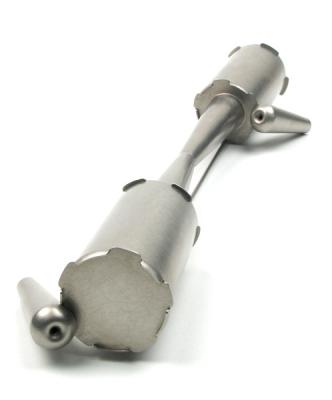
Working in this way is very much improvisation within a structured aim. Working in a way that generates forms that appear superficially familiar or representational yet remain quite ambiguous, it is not so easy for people to bring their perceptions to a neat resolve. As a result, the perceptual process is open ended and extended.
Most of what I have mentioned here is only clear when directly handling and wearing the physical objects. Unfortunately, most people only know my work via photographs, which are static visual representations that can barely even capture the surfaces from one viewpoint. To read my work through a photograph is like reading a book by its cover.
Do you think about your objects being worn? How do you think they change when they are seen on the body?
Simon Cottrell: Of course I think about my works being worn. This is my primary concern. Surely, that is a fundamental consideration for any jeweler who wants to provide objects that people can and will relate to for a prolonged period.
How do I think they change when worn? This is very hard to generalize as no two pieces are ever the same. My brooches are not at all flat, so when seen off the body, it can be hard to understand how they might be worn. I am extremely careful to make sure that my works are not only wearable, but that they are variable in the way they can be worn. I have never declared which way is up with my brooches. Most of my work can be rotated and worn at whatever angle the wearer chooses. While this is easy with flat jewelry, with forms as voluminous as my own work, this can be very hard to achieve.
My brooches can be quite large and complex, but by maintaining a uniform color across each piece, they tend to appear far more restrained when worn. Another contradiction in my work is this monotone color across forms and structures that are enormously diverse in their overall physical dynamics.
While I know that my work is certainly not the kind of jewelry that everyone would be willing to wear, I am in no way aiming for mass appeal. But even still, nearly every jewelry piece I have made in the past 15 years is in the hands of private collectors who choose to wear them as an extension of their personal identity. So, I cannot help but feel that this is an affirmation of their wearability. This is something that I am quite proud of.
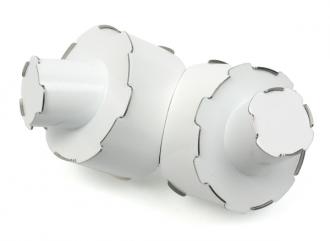
There is a very industrial, contemporary aesthetic in your work. Is it made using modern materials and processes or craft processes and materials that you’d find in more conventional-looking jewelry?
Simon Cottrell: In essence, the technical processes are quite familiar to those that a goldsmith or jeweler might use, although the processes have needed to be developed and adapted to the specifics of the alloy I use. I only know of four other people who have used Monel to make jewelry. It is a rather unforgiving and challenging metal to work with. Its properties provide little room for error, but it is certainly well worth the effort.
All elements are hand cut and solder fabricated. Each element is made independently in response to the relationships between the elements that immediately preceded them. Many people assume that my work must be laser cut, but because no two forms are ever repeated exactly, it would actually take far longer to have them laser cut than it would to make them by hand. More importantly for me, hand building allows for a more incrementally intuitive progression of making that flows smoothly in a direct response to prior actions. While there is quite a bit of precision in these works, they are never measured or mathematically precise. Each element is made directly to physically fit the previous. I never aim for exact repetition or re-iteration of forms. Someone once described the forms in my work as “rhyming” rather than “repeating.”
I have recently done some laser cutting in small and simple production pieces that can be repeated, but these specific elements are limited in their adaptability for more improvised works.
What about touch? It seems like fingerprints would destroy the perfection of your work!
Simon Cottrell: The particular metal I use, monel400, is a very high-tech alloy. It is more stainless than stainless steel. It is an extremely strong metal that is resistant to wear, and it is more resistant to corrosion than surgical steels or even some grades of titanium. Its strength provides great durability and structural integrity, which means that people do not need to feel precious about wearing my work. I know people who have owned my brooches for more than 10 years, and they still look the same as they did when they were first completed. The surfaces never change. As I said earlier, this alloy is very hard to work with, but it is certainly worth the effort.
If this alloy does get fingerprints, they could not be any easier to remove. Under warm water with a mild detergent, wipe the piece all over with a long- and soft-bristled brush, give it a good rinse, and dry with a clean non-abrasive cloth or even a hairdryer, then it will be as good as new. Fingerprints are less of a danger to my work than food is to your dinner plates. And what’s more, I can confidently say that my work is dishwasher safe.
My initial attraction to this material was its strength and its very neutral grey color. I do not like the color of other metals of similar hardness. The blue hues of stainless steel or the brown hues of titanium are too loaded for me. Monel is a much more sedate, almost pure grey. Because of this, it can integrate more easily with other aspects of a wearer’s visual identity. It may still be a contrast, but it is a more gentle one.
I could make my work much cheaper using silver, but then the pieces would need regular cleaning, which would be utterly impossible to do evenly. They would also need to be thicker and heavier. Even still, they would be nowhere near as durable.
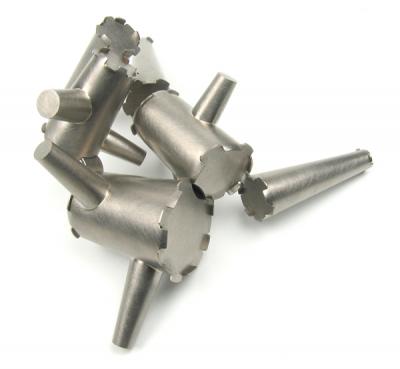
“Improvisation is just composition sped up” Arnold Schoenberg, twentieth-century German composer
Simon Cottrell: There seems to be a great misconception that improvisation must be open ended in a messy or haphazard manner. I have much more respect for the depth of awareness and discourse around improvisational process within musical theory than I do for the relatively superficial definition that it seems to retain within visual culture.
While the text Improvisation: Its Nature and Practice in Music by Derek Bailey (first published in 1982) is written by a musician, it is very much focused on the fundamentals of intuitive process and progression rather than specifically about music as a mode of working. I initially read this book in the 1990s to gain insights into the processes he used as a guitarist, but many regard Bailey’s book as the most articulate text on improvisatory process because it transcends the chosen medium of its writer. I would recommend this text to anyone with any interests in creative, intuitive progression.
Improvisation is not necessarily more open ended than any other approach to creative process. Structured improvisation is a term that I borrow from improvised music. It refers to the process of intuitively working within cognitively pre-set parameters. While working in this way, I do not have any clarity as to what forms will result at the end point of making, but I do have a clear set of aesthetic aims and priorities that direct my making processes as they unfold through real-time progression.
With a greater depth of cognitive awareness to the technical limitations in which one works, a more structured framework can refine potentials of aesthetic aims. And in turn, with greater awareness to many potential aesthetic aims and intentions, the technical framework can be further refined. The relationship between these circular processes does not undermine intuitive progression, it simply refines the potentials of the remaining variables. In the simplest sense, the theory of structured improvisation implies a subconscious that is intuitively furthering a bank of prior insights within cognitive presets.
I am never quick to assess if any finished work is unsuccessful. Often, works that I am uncertain about will sit and wait for many months before I decide what to do with them. Due to the nature of the building processes that I use, I can easily take a few steps in reverse, deconstruct, and rebuild pieces in a different direction until I am satisfied with the outcome. Quite often, there are pieces that I was very satisfied with on completion, but over time, once my aesthetic aims and priorities shift, I can decide to go back and rework or take things further again.
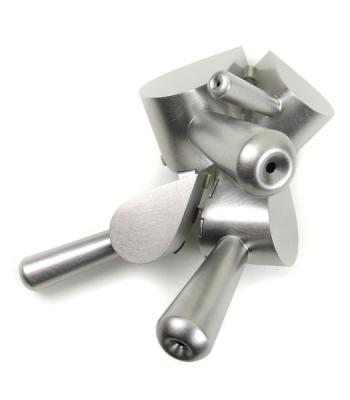
Simon Cottrell: Who was it that said that the most significant aspect of abstract art lies precisely in its ambiguity, which has the ability to suggest everything and nothing at the same time?
Perception, especially of abstract form, is predominantly a mental activity. It is not more than half directed by the tangible visual stimulus that is perceived. The values and prior interests and awareness of the perceiving mind have a great role in directing and shaping our perceptions. I find your reading of gemstone claws in my work to be a very interesting perception. It’s one that I’ve only heard once before. After giving a lecture in Auckland back in 2005, Warrick Freeman once offered this same reading of my work.
As the processes and variability of perception of abstract forms are so intriguing to me, on hearing Warwick’s perception I could not help but ponder the processes of its formation. On the occasions that he uses claws, they are often at the very edges of broad planar surfaces that share their outlines with the reductive forms of the jewelry itself. Has a raised awareness to the context of claws in his own work in some way influenced the way his subconscious reads the details within my work? To my own senses, I find much more within my work that would undermine any perception of claws. It is a significant difference of perception, yes? Susan, I cannot help but ponder exactly what is aiding your perception of claws?
Do not get me wrong. I am in no way attempting to negate the perceptions of others. I truly love to hear the diversity of readings people take from my work. While I have often said that my work never aims to communicate anything specific, more simply I aim to give the wearer a personal sensory experience, in an unfolding, ongoing, quiet but resonant manner, with an endless amount of possible readings. I have no interest in evoking clear, resolved perceptions. If there is a line between this work being perceived in either one way or another, I will usually try to sit on that line.
An Australian collector recently told me that he sees my work like a Rorschach inkblot test, in that the pieces trigger such a broad diversity of readings that reveal more about the viewer than they do about object being perceived.
I have never made a conscious effort to refer to jewelry history in my work. I can confidently say that I have actively aimed to avoid definitive visual reference to any specific subjects, and this includes jewelry. My work is not aiming to be about jewelry in any way, it more simply just is jewelry.
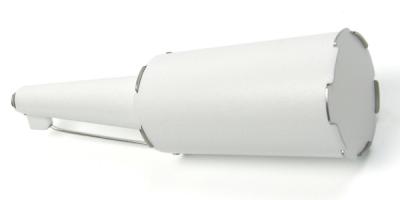
Simon Cottrell: Most often, my titles are directly descriptive of the basic forms or sometimes of familiar things that the completed pieces visually hint at. I do not intend for the titles to offer anything that the pieces do not. The only exceptions would be the handful of times when a title refers to an earlier piece from which a new piece was made in direct response to.
While I am well aware of the communicative value that a title can potentially have, I don’t feel my titles are in any way crucial to the framing of the work. I have no interest in dictating anything definitive to anyone, whether they be a wearer, a viewer, or otherwise.
Honestly, my titles are only ever applied when the piece is completed and I need to record its existence. For a long while, I have wondered if the term “title” is actually all that fitting. Maybe a “catalogue reference” is a more apt definition.
Thank you.




